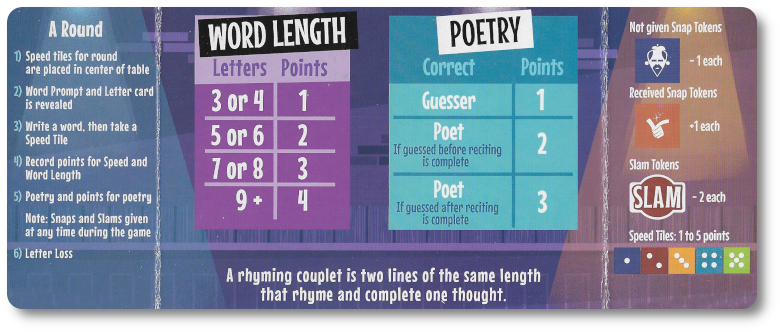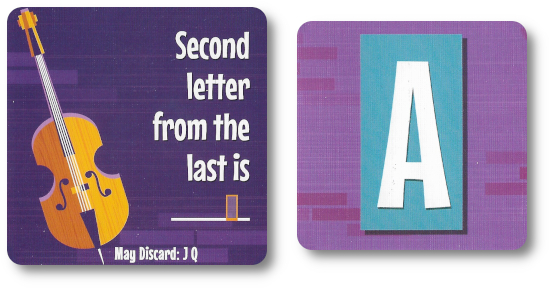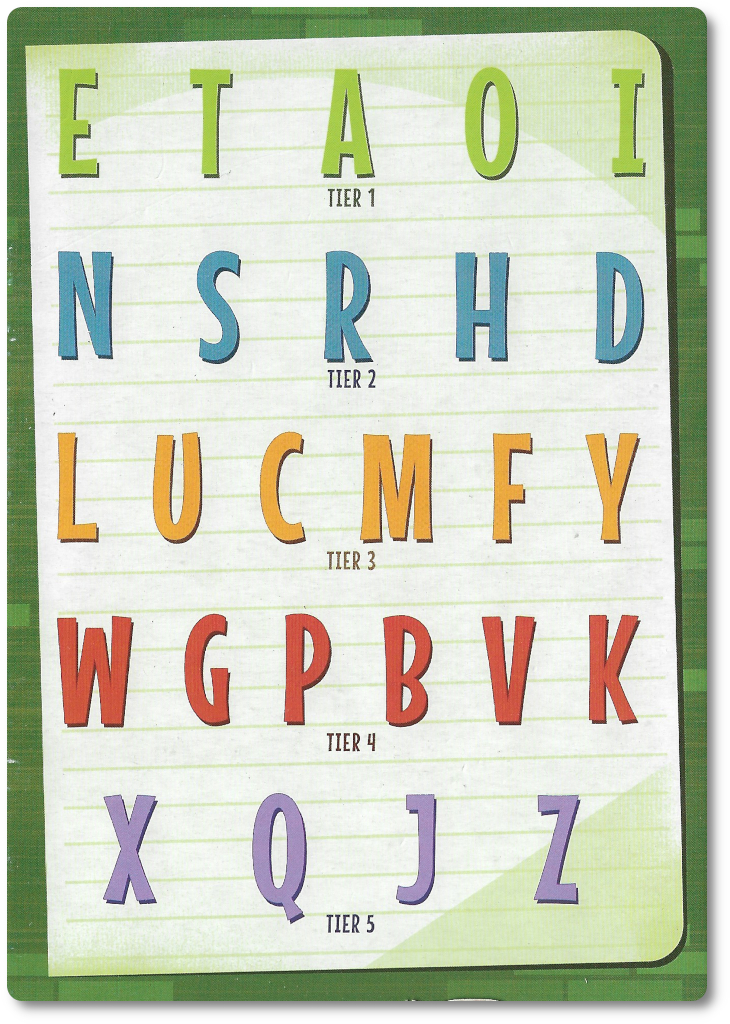
The Basics:
- For ages 10 and up
- For 3 to 10 players
- Approximately 60 minutes to complete
Geek Skills:
- Active Listening & Communication
- Counting & Math
- Logical & Critical Decision Making
- Reading & Writing
- Imagination
Learning Curve:
- Child – Easy
- Adult – Easy
Theme & Narrative:
- Rhyming is hard
Endorsements:
- Gamer Geek rejected!
- Parent Geek approved!
- Child Geek rejected!
Overview
American poet, Robert Frost, said “Poetry is when an emotion has found its thought and the thought has found words.” Which begs the question what is going on when my youngest says, “Roses are red, violets are blue, I got some gum stuck to my shoe.” Which he did. Poetry, it would seem, can be about anything. Emotional, entertaining, and downright odd. It all works. Which is good because that’s what this game requires.
Poetry Slam, designed by Adam Wyse and published by Mayday Games, is comprised of 26 Letter cards, nine Word Prompt cards, 50 Speed tiles, 30 Snap tiles, 70 Lost Letter chips, 50 Slam tokens, 10 Player boards, 10 Player screens, 10 pencils, and one score pad. All the components are of excellent quality. Solid plastic, cardstock, and cardboard throughout, making the game very durable.
Game Set Up
To set up the game, first shuffle the Word Prompt cards and place the deck face-down in the middle of the playing area. This is the Word Prompt draw deck for the duration of the game.
Second, shuffle the Letter cards and place the deck face-down next to the Word Prompt draw deck. This is the Letter draw deck for the duration of the game. Next to this draw deck, place in a pile the Slam tokens and Lost Letter chips. I suggest you use small bowl just to keep things tidy, but it’s not necessary to do so.
Third, give each player a a Player screen, a Player board, three Snap tiles (placed with the “Beatnik” side facing up), a score sheet from the score pad, and a pencil.

The Player screen does a great job of summarizing the game
Fourth, randomize the Speed tiles and draw a number based on the number of players in the game. Players now take the Lost Letter chips and place them on any letter of their choice on their Player board that matches the value of the Speed Tiles drawn. Each Speed Tile value represents a tier value on the Player board. For example, a Speed Tile with the value of “five” means the players must place a Lost Letter tile on tier five of their Player board. Return the drawn Speed tiles to the pile.
Fifth, designate one player to be the “Wordsmith”. The Wordsmith shuffles the Speed tiles, ensuring the point values are face-up. Then the Wordsmith forms a row using the Speed tiles with the highest value (five) on the fare left and proceeding right in descending value (lowest value is one) to create a pattern. After the lowest value is placed, start over in the same row, continuing the pattern. For example, a row would have the values “5, 4, 3, 2, 1, 5, 4, 3, 2, 1” and so on.
That’s it for game set up. Time to slam!
Rock That Mic!
Poetry Slam is played in rounds with the total number of rounds played based on the number of players in the game. A round of game play is summarized here.
Step One: Remove Speed Tiles
The Wordsmith removes a number of Speed tiles equal to the number of players from the left end of the row they made during game set up. These tiles are then placed towards the center of the playing area for all to see and within easy reach.
Step Two: Get Your Word Prompt
The Wordsmith draws the top-most Word Prompt card from the Word Prompt draw deck, placing it face-up. Then the Wordsmith draws at least one Letter card from the Letter draw deck (more might be required per the drawn Word Prompt card), placing it face-up next to the drawn Word Prompt card.

In this example, the word must have an “A” as a second letter from the last….
Step Three: Write Words
As soon as the Word Prompt and Letter cards are drawn and visible, all players may immediately start writing a single word on their score sheet in the row that corresponds with the current round. Use the Word Prompt and Letter cards to assist in determining what word to write. The Player screen should be used to ensure the player’s word of choice is kept a secret. There are a few rules when it comes to writing a word.

- Words must use the rules provided by the Word Prompt and Letter card
- Words must be at least three letters long
- Words cannot be a proper noun
- Words must be in the English dictionary (needed in case there is a word challenge)
- Words cannot be a contraction
- Words cannot be an abbreviation or an acronym
- Letters marked as “lost” cannot be used in the word
Step Four: Grab Those Speed Tiles
As soon as a player has completed writing their word, they may reach for any available Speed tiles set aside by the Wordsmith during step one of the round. The higher the Speed tile value, the more points the player can earn. However, the most valuable letters are also in the highest value tiers. This means the players will have to play a bit of win/lose when selecting the Speed tile.
Step Five: Record Points
After the player grabs a Speed tile, they record the point values earned on their score sheet. Points are earned based on the value of the Speed tile and the number of letters in the player’s word
Step Six: Let’s Rhyme
After all the players have recorded their points, each player now creates a rhyme using the word the player wrote. Each rhyme must be a couplet, which is two lines of the same length that both rhyme and complete a single thought. Difficult? Sure, but it gets harder still. The rhyme must not include the word the player wrote, but the rhyme should clue the player’s opponents in on what that word is.
For example, if I wrote down the word “drugstore”, I could write the following really bad poem:
“If you were hit hard in the header,
go to this shop to get yourself better.”
There is no turn order sequence here, so whoever wants to go first may do so. Each player reads their poem once and each player can only guess what an opponent’s word is once per poem. Guesses do not need to be exact. The rules are a bit loosey-goosey and leave the final decision up to the poet.
If the word is guessed correctly, the player who guessed gets one point (recorded on their score sheet). If the word is guessed before the poet finishes their rhyme, the poet gets two points. If the word is guessed after the rhyme, the poet gets three points. As you can see, it’s in the poets best interest to ensure their poem helps their opponents correctly guess the word, but not right away.
Each player is given a Snap token at the start of the game with the Beatnik side facing up. If a player is impressed with an opponent’s poem, they can award them with a “Snap” and give them one of their tokens, which is placed in front of the opponent with the “Snap” side face-up. Snap tokens withe the “Snap” side face-up award the player an additional bonus point, while any Snap tokens with the Beatnik side reduce the player’s score by one point.
Each player is also given Slam tiles. These are given to opponents that mess up. For example, the word does not match the Word Prompt card rule, the word is spelled incorrectly, or uses any of the lost letters (unless the Word Prompt card requires the player use a specific letter). Each Slam reduces the player’s score at the end of the game by minus two.
This step continues until all players have read their poems. If a player cannot come up with a rhyme, they must pass. Additionally, if the poem doesn’t rhyme or is not sufficient per the groups agreed upon satisfaction, it’s also skipped.
Step Seven: Lose Letters
After all the poems are read and points are scored, players flip over their collected Speed tile and mark the displayed letter on the tile on their Player board, covering it with a Lost Letter chip. If the indicated letter is already covered, the player must cover another letter in the same tier value. If all the letters are covered in the tier, the player must select a letter in the next tier below or from above (if the player is already on the lowest row). Note that some Speed tiles will only indicate a tier, in which case the player may select the letter of their choice in the indicated tier.

After all players have completed covering up a letter on their Player board, the Speed tiles, Word Prompt card, and Letter card are discarded. A new round now begins.
Closing the Curtain
The game ends after the noted number of rounds is complete. Players determine their final score and announce the value. Whoever has the most points wins the game.
Game Variant
If playing with younger players or with folks who are just not great at creating rhymes, this game variant allows the players to create free-form poems. No rhyming or common meter is required. Essentially, the player can just say a sentence that describes their word without giving it away. Creativity is still required, but without the extra effort of making sure everything rhymes.
To learn more about Poetry Slam, visit the game’s web page.
Final Word
 The Child Geeks didn’t care much for this game. According to one Child Geek, “It’s hard to rhyme and even harder to create a poem that’s about my word.” The game, instead of entertaining, frustrated our youngest players, eventually causing several of our gaming groups to end the game before the game was technically supposed to come to a conclusion. Another Child Geek said, “I like reading poems that are funny, and I like hearing other people’s poems, but I don’t like writing or reading mine.” The game itself was clearly understood by our players and they all demonstrated they knew how the words were to be written and how letters, as the game progressed, were off-limits. But, in truth, it was this steady and unstoppable progression of difficulty in a game that turned the Child Geeks into a grumpy group. As a result, they rejected Poetry Slam.
The Child Geeks didn’t care much for this game. According to one Child Geek, “It’s hard to rhyme and even harder to create a poem that’s about my word.” The game, instead of entertaining, frustrated our youngest players, eventually causing several of our gaming groups to end the game before the game was technically supposed to come to a conclusion. Another Child Geek said, “I like reading poems that are funny, and I like hearing other people’s poems, but I don’t like writing or reading mine.” The game itself was clearly understood by our players and they all demonstrated they knew how the words were to be written and how letters, as the game progressed, were off-limits. But, in truth, it was this steady and unstoppable progression of difficulty in a game that turned the Child Geeks into a grumpy group. As a result, they rejected Poetry Slam.
 The Parent Geeks were a different story. They had a great time with the game, but not everyone had the same level of fun. According to one Parent Geek, “I love word games and I have never played a game that combined vocabulary with poetry. A really unique idea that was fun to play and compete against others with.” For those Parent Geeks who already loved word games and were self-described “creatives”, Poetry Slam was a real hoot. The less creative and less enthralled Parent Geeks still had a good time, but for different reasons. As one such Parent Geek put it, “Like all party games, I don’t care too much about what I’m playing so much as who I am playing with. This game was entertaining and I laughed more than frowned. A good game to play with friends and a glass of wine.” When all the poems were read and fingers snapped, the Parent Geeks agreed to approve Poetry Slam.
The Parent Geeks were a different story. They had a great time with the game, but not everyone had the same level of fun. According to one Parent Geek, “I love word games and I have never played a game that combined vocabulary with poetry. A really unique idea that was fun to play and compete against others with.” For those Parent Geeks who already loved word games and were self-described “creatives”, Poetry Slam was a real hoot. The less creative and less enthralled Parent Geeks still had a good time, but for different reasons. As one such Parent Geek put it, “Like all party games, I don’t care too much about what I’m playing so much as who I am playing with. This game was entertaining and I laughed more than frowned. A good game to play with friends and a glass of wine.” When all the poems were read and fingers snapped, the Parent Geeks agreed to approve Poetry Slam.
 The Gamer Geeks liked what the game was trying to do but found the process to be heavy-handed. According to one Gamer Geek, “I really like how the game aggressively and steadily gets harder the longer you play it. But this is not a game I would ever want to play again. Great experience, but one I will not be repeating.” Some of the Gamer Geeks got really into it while others did not. One such Gamer Geek said, “You can earn extra points by being creative or earn points for not. Either way, the game gives you points for just being at the table. I never felt fully invested as a result, or cared how many points I earned because they came pretty easy.” Players do have to work harder to earn more points, but for those who felt that party games were more about the playing than the winning, they didn’t see the point in putting in a lot of effort. The Gamer Geeks rejected Poetry Slam, liking it for what it was, but no interest in playing it.
The Gamer Geeks liked what the game was trying to do but found the process to be heavy-handed. According to one Gamer Geek, “I really like how the game aggressively and steadily gets harder the longer you play it. But this is not a game I would ever want to play again. Great experience, but one I will not be repeating.” Some of the Gamer Geeks got really into it while others did not. One such Gamer Geek said, “You can earn extra points by being creative or earn points for not. Either way, the game gives you points for just being at the table. I never felt fully invested as a result, or cared how many points I earned because they came pretty easy.” Players do have to work harder to earn more points, but for those who felt that party games were more about the playing than the winning, they didn’t see the point in putting in a lot of effort. The Gamer Geeks rejected Poetry Slam, liking it for what it was, but no interest in playing it.
 Poetry Slam is an interesting concept that depends a great deal on the people playing it being energetic and creative. Yes, you could say that about many party games, but it’s very important to the game play that each and every player know how to rhyme or the game starts to fall flat. Too many times we had groups scratching their heads when trying to figure out a word or getting the word right off the bat. There never appeared to be “middle ground” during the game play. It was either too easy or strangely difficult. As such, the game never found solid footing except with groups that were perfectly matched to the game’s required energy and creativity it demands.
Poetry Slam is an interesting concept that depends a great deal on the people playing it being energetic and creative. Yes, you could say that about many party games, but it’s very important to the game play that each and every player know how to rhyme or the game starts to fall flat. Too many times we had groups scratching their heads when trying to figure out a word or getting the word right off the bat. There never appeared to be “middle ground” during the game play. It was either too easy or strangely difficult. As such, the game never found solid footing except with groups that were perfectly matched to the game’s required energy and creativity it demands.
One point that should be made is that the free-form game variant should be the standard and the rhyming should be the variant. The game is difficult enough with the letter reduction and the random word creation requirements. Tacking on the rhyming requirement felt like too much for the players to handle. You can easily reduce the “load” by allowing players to rhyme if they want to. Nothing about the game becomes truly easier, but the game does feel a lot less stressful. And less stress makes for more fun which leads to more energy and more creativity. Something to consider.
Overall, I really liked what the this game was about but it demands a lot of its players for a party game. Poetry Slam is the kind of game I’d take to a class room learning about poetry or to a book club. This is also a game you will play once and put on your shelf for a bit. It demands a lot of creative energy and that can feel draining. The game can be seen as “work” rather than “play”, which is never a good thing.
All that being said, I still think you should try it. I haven’t seen a game like this before and I liked how it was pushing the envelope. Not for me, but I liked the idea. Who knows. You might be a poet and not even know it. Give it a try and see if you want to buy. Or maybe you’ll say no without giving it another go.
I’ll stop now….
This game was given to Father Geek as a review copy. Father Geek was not paid, bribed, wined, dined, or threatened in vain hopes of influencing this review. Such is the statuesque and legendary integrity of Father Geek.
Discover more from Father Geek
Subscribe to get the latest posts sent to your email.





